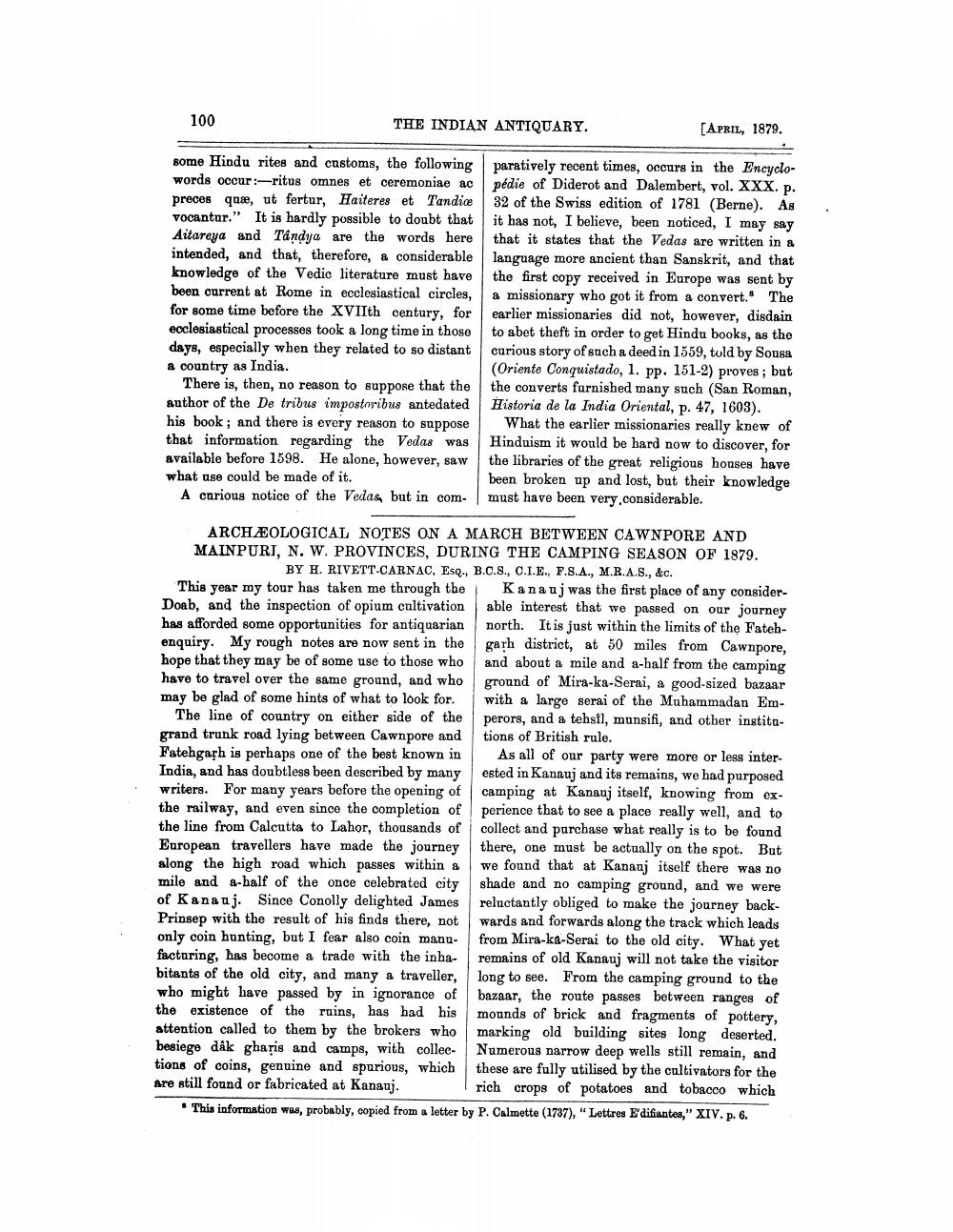________________
100
THE INDIAN ANTIQUARY.
some Hindu rites and customs, the following words occur:-ritus omnes et ceremoniae ac preces quæ, ut fertur, Haiteres et Tandice vocantur." It is hardly possible to doubt that Aitareya and Tandya are the words here intended, and that, therefore, a considerable knowledge of the Vedic literature must have been current at Rome in ecclesiastical circles, for some time before the XVIIth century, for ecclesiastical processes took a long time in those days, especially when they related to so distant a country as India.
There is, then, no reason to suppose that the author of the De tribus impostoribus antedated his book; and there is every reason to suppose that information regarding the Vedas was available before 1598. He alone, however, saw what use could be made of it.
A carious notice of the Vedas, but in com
[APRIL, 1879.
paratively recent times, occurs in the Encyclopédie of Diderot and Dalembert, vol. XXX. p. 32 of the Swiss edition of 1781 (Berne). As it has not, I believe, been noticed, I may say that it states that the Vedas are written in a language more ancient than Sanskrit, and that the first copy received in Europe was sent by a missionary who got it from a convert. The earlier missionaries did not, however, disdain to abet theft in order to get Hindu books, as the curious story of such a deed in 1559, told by Sousa (Oriente Conquistado, 1. pp. 151-2) proves; but the converts furnished many such (San Roman, Historia de la India Oriental, p. 47, 1603).
What the earlier missionaries really knew of Hinduism it would be hard now to discover, for the libraries of the great religious houses have been broken up and lost, but their knowledge must have been very.considerable.
ARCHEOLOGICAL NOTES ON A MARCH BETWEEN CAWNPORE AND MAINPURI, N. W. PROVINCES, DURING THE CAMPING SEASON OF 1879. BY H. RIVETT-CARNAC, Esq., B.C.S., C.I.E., F.S.A., M.R.A.S., &c. This year my tour has taken me through the Doab, and the inspection of opium cultivation has afforded some opportunities for antiquarian enquiry. My rough notes are now sent in the hope that they may be of some use to those who have to travel over the same ground, and who may be glad of some hints of what to look for.
Kanauj was the first place of any considerable interest that we passed on our journey north. It is just within the limits of the Fatehgarh district, at 50 miles from Cawnpore, and about a mile and a-half from the camping ground of Mira-ka-Serai, a good-sized bazaar with a large serai of the Muhammadan Emperors, and a tehsil, munsifi, and other institutions of British rule.
The line of country on either side of the grand trunk road lying between Cawnpore and Fatehgarh is perhaps one of the best known in India, and has doubtless been described by many writers. For many years before the opening of the railway, and even since the completion of the line from Calcutta to Lahor, thousands of European travellers have made the journey along the high road which passes within a mile and a-half of the once celebrated city of Kanauj. Since Conolly delighted James Prinsep with the result of his finds there, not only coin hunting, but I fear also coin manufacturing, has become a trade with the inhabitants of the old city, and many a traveller, who might have passed by in ignorance of the existence of the ruins, has had his attention called to them by the brokers who besiege dak gharis and camps, with collections of coins, genuine and spurious, which are still found or fabricated at Kanauj.
As all of our party were more or less interested in Kanauj and its remains, we had purposed camping at Kanauj itself, knowing from experience that to see a place really well, and to collect and purchase what really is to be found. there, one must be actually on the spot. But we found that at Kananj itself there was no shade and no camping ground, and we were reluctantly obliged to make the journey backwards and forwards along the track which leads from Mira-ka-Serai to the old city. What yet remains of old Kanauj will not take the visitor long to see. From the camping ground to the bazaar, the route passes between ranges of mounds of brick and fragments of pottery, marking old building sites long deserted. Numerous narrow deep wells still remain, and these are fully utilised by the cultivators for the rich crops of potatoes and tobacco which
This information was, probably, copied from a letter by P. Calmette (1737), "Lettres E'difiantes," XIV. p. 6.




